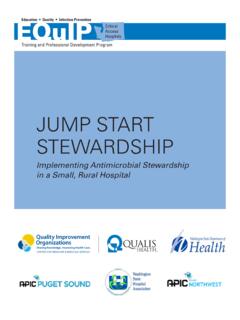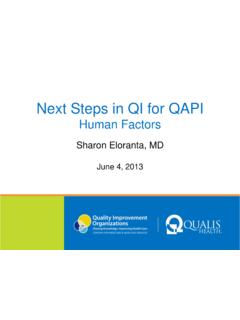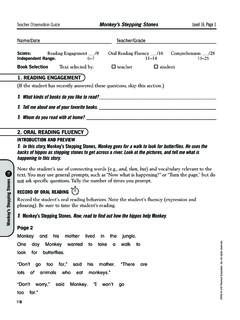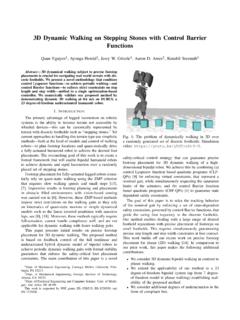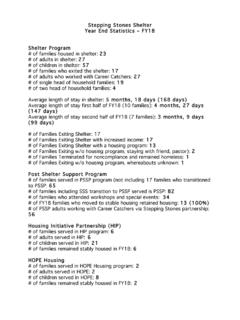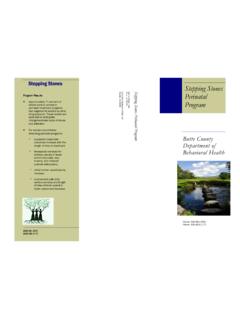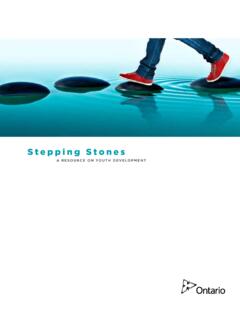Transcription of The Stepping Stones Project - Qualis Health
1 The Stepping Stones Project :Final Report to the Community2008 2011 July 2011 Amendment: January 2013 The Stepping Stones Project was featured in the January 23rd issue of the Journal of the American Medical Association (JAMA) as part of an article focusing on Medicare QIO-led care transitions initiatives 2011 2 Introduction Stepping Stones : Bridging Healthcare Gaps (The Care Transitions Project of Whatcom County) aimed to engage the community and activate patients and healthcare providers to eliminate unnecessary readmissions to PeaceHealth St. Joseph Medical Center. Studies across the country have demonstrated that there are potential gaps in communication and coordination when patients move from one setting or aspect of care to another resulting in patient risk and increased costs.
2 The aim of this Project was to bridge those gaps and enable safer and more effective Centers for Medicare & Medicaid Services (CMS) contracted with Qualis Health (Washington s Medicare quality improvement organization) to engage community partners including healthcare providers, patients, and families, in the August 2008 through July 2011 Project . The Stepping Stones Project was one of only 14 such Medicare demonstration studies across the together, Qualis Health and the Whatcom County community made substantial progress across the Project s three goals: Connect providers throughout the healthcare system in Whatcom County to enable safe and effective transition of patients. Eliminate unnecessary hospital readmissions to PeaceHealth St.
3 Joseph Medical Center. Enable Whatcom County patients and their families to participate fully in their Health and healthcare, particularly when leaving the key result was a reduction in hospital readmissions among all Medicare beneficiaries in this community over a two-year period. This reduction reflects an 8% relative improvement Results in 8% Improvement in ReadmissionsFigure 1: 30-Day Readmissions in Whatcom County Data Source: Medicare Fee-For-Service claimsThis report tells the story of the Project , its activities, and its accomplishments. Readmissions within 30 Days per 1,000 Medicare Fee-for-Service Eligible Beneficiaries in Whatcom CountyRemeasurement 10/1/09 - 3/31/10$2417% 10/1/07 - 3/31 is betterThis material was prepared by Qualis Health , the Medicare Quality Improvement Organization for Idaho and Washington, under a contract with the Centers for Medicare & Medicaid Services (CMS), an agency of the Department of Health and Human Services.
4 The contents presented do not necessarily reflect CMS policy. 9 SOW-WA-CTS-QH-546R-02-13 July 2011 3To guide the work, Qualis Health engaged with the Whatcom County community to form a steering committee comprising the target hospital, community providers, stakeholders, and patient representatives. The steering committee endorsed a framework to achieve sustainable progress across five strategic areas centered on the needs of the patient, as shown in the diagram below. The following sections of this report address each of these areas of 2: Strategic AreasFamily/Patient Self-Management and Community ResourcesPhysician & HealthcareContinuity HospitalDischargeIT Development ResourcesAnalytics and Communications ResourcesConnect providers throughout the healthcare system in Whatcom County to enable safe and effective transition of patients.
5 Eliminate unnecessary hospital readmissions to PeaceHealth St. Joseph Medical Center. Enable Whatcom County patients and their families to participate fully in their Health and healthcare, particularly when leaving the 2011 4 Strategic Area 1:Family/Patient Self-Management Evidence suggests that patients and families who take an active role in managing their healthcare have fewer readmissions to the hospital. The Stepping Stones Project developed and implemented multiple strategies to increase family and patient activation on behalf of their own or loved one s healthcare, and to support safe and effective care Transitions CoachingTransition coaching is based on the Care Transitions Intervention developed by Eric Coleman, MD, an evidence-based model that is linked to reduced readmission rates.
6 The transitions coach supports patients over a four-week period that includes a visit to the patient in the hospital or skilled nursing facility, one home visit, and three follow-up phone calls. Patients with complex care receive specific tools and with the help of the Transitions Coach learn self-management skills to ensure their needs are met during the transition from hospital or facility to Care Transitions Intervention focuses on four conceptual areas, referred to as pillars: Medication self-management Use of a dynamic patient-centered Health record Follow-up care Red flags (signs of a worsening condition, and what to do about them)The Project sponsors turned to the community and the local university to develop a volunteer coaching program.
7 The program would not have been possible without the significant support of the hospital, including office space and IT access for the program coordinator. Volunteer coaches were integrated into the hospital volunteer department to address patient access, privacy, and supervisory affiliation issues. A Qualis Health care transitions specialist served as coach coordinator, designing structures and processes for implementation. Since CTI is not oriented toward volunteers, this involved a significant commitment of resources, including initial and ongoing coach recruitment, as well as careful screening and selection of volunteers. Once recruited, the volunteers received intensive training in the model and then ongoing support and mentoring as they began coaching in the community.
8 The level of supervision decreased as the coaches skill and confidence increased. A coaching community of practice was formed to address the challenges relating to all aspects of volunteer was a strong relationship between the number of coaching encounters a patient had and the 30-day readmission date. The more encounters, the lower the readmission rate. Additionally, the mean days to rehospitalization increased with number of coaching Reduces 30-Day ReadmissionsFigure 3: Coaching and 30-Day Readmissions Data Source: Medicare FFS claims, PeaceHealth St. Joseph Medical Center30-Day Readmission Rate1614121086420 Lower is Readmission RateReadmission for Coached PatientsJuly 2011 5 Along with coaching, the Patient Activation Measure (PAM) was used.
9 The PAM is a survey that assesses the knowledge, skills, and confidence integral to managing one s own Health and healthcare. This was one of the first times the PAM was used in conjunction with transitions coaching. Combining these two tools revealed significant correlation between coaching and patient activation. From January 2009 through May 2011, over 400 people were coached (using an average of 150 volunteer hours per month). Self-management skills increased for those who were coached; there was a readmit rate for patients who completed all five coaching encounters. This contrasts with the readmission rate for similar discharged patients who were not coached. Care Transitions Coaching Helped Reduce Readmissions for Dual-Eligible PatientA Qualis Health care transitions coach worked with a dual-eligible (Medicare/Medicaid) beneficiary with multiple chronic illnesses on how to better manage her own care.
10 For seven months, she remained in her own home and successfully managed to avoid a return trip to the hospital quite an improvement compared to the previous 13 months, when she was hospitalized nine times. Nine typical readmissions cost approximately $86,400 based on Medicare s estimates of $9,600 for each admission or the first coaching meeting, the beneficiary and her family caregiver were overwhelmed and unable to mobilize self-management skills. Over the course of a month, the coach helped the beneficiary and her caregiver on the four pillars (medication reconciliation, physician follow-up, red flags, and personal Health record). The coach also referred them to existing community services, where the caregiver was able to receive further time, the pair became much more activated in her care.
